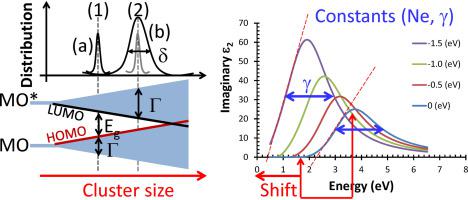当前位置:
X-MOL 学术
›
Diam. Relat. Mater.
›
论文详情
Our official English website, www.x-mol.net, welcomes your
feedback! (Note: you will need to create a separate account there.)
Optical Measure of Disorder: Why Urbach analysis works for Amorphous Silicon but fails for Amorphous Carbon
Diamond and Related Materials ( IF 4.3 ) Pub Date : 2020-12-01 , DOI: 10.1016/j.diamond.2020.108137 David V. Tsu , Thomas Schuelke , John Slagter
Diamond and Related Materials ( IF 4.3 ) Pub Date : 2020-12-01 , DOI: 10.1016/j.diamond.2020.108137 David V. Tsu , Thomas Schuelke , John Slagter

|
Abstract We investigate the basis for the Paradox where the Urbach-slope disorder parameter disagrees with the Raman width in amorphous diamond-like carbon (DLC) materials (lower Urbach-Eo yet greater Raman width). We examined the bandgap and Urbach-slope measurement issues. While significant errors are identified, ultimately these cannot resolve the Paradox. This resolution involves large changes in shape of DLC’s absorption band resulting from large energy shifts. To solidify the understanding of band energy shifts, we examined their properties using a-Si:H, well known for its agreement between Raman and Urbach-slope disorder parameters. Using Tauc-Lorentz (T-L) dispersion functions, the Urbach method works for a-Si:H because small changes in shape occur, as measured by (i) peak position, (ii) peak width, (iii) peak amplitude, and (iv) and gap energies. Moreover, for a-Si:H, a 5th condition (v) there is no other feature below the principal band to interfere with its fall. All 5 of these conditions fail for DLCs. Because T-L dispersions accommodate asymmetry, we traced the Paradox to a steepening of the band shape as it pushes toward lower energy. This steepening is unrelated to disorder, but to a boundary value problem where energy cannot be negative. We conclude that Urbach analysis is invalid for DLC materials, but the T-L width is a good measure instead. We also examined another disorder measure, where π bonds should be considered as disorder relative to the σ bonds in an idealized “amorphous diamond” sp3 network: superconvergence can be used to quantify these π transitions. Finally, further molecular orbital calculations are needed to properly interpret the changes in T-L widths.
中文翻译:

无序的光学测量:为什么 Urbach 分析适用于非晶硅而不适用于非晶碳
摘要 我们研究了悖论的基础,即 Urbach 斜率无序参数与无定形类金刚石碳 (DLC) 材料的拉曼宽度不一致(Urbach-Eo 较低但拉曼宽度较大)。我们检查了带隙和 Urbach 斜率测量问题。虽然发现了重大错误,但最终这些都无法解决悖论。该解决方案涉及由大的能量转移引起的 DLC 吸收带形状的大变化。为了巩固对能带能量偏移的理解,我们使用 a-Si:H 检查了它们的特性,众所周知,它在拉曼和 Urbach 斜率无序参数之间的一致性。使用 Tauc-Lorentz (TL) 色散函数,Urbach 方法适用于 a-Si:H,因为形状会发生微小变化,如 (i) 峰位置、(ii) 峰宽、(iii) 峰幅度、(iv) 和间隙能量。此外,对于 a-Si:H,第 5 个条件 (v) 在主带以下没有其他特征会干扰其下降。对于 DLC,所有这 5 个条件都失败了。因为 TL 色散适应不对称性,我们将悖论追溯到带形状的陡峭,因为它向较低的能量推动。这种陡峭与无序无关,而是与能量不能为负的边界值问题有关。我们得出结论,Urbach 分析对 DLC 材料无效,但 TL 宽度是一个很好的衡量标准。我们还检查了另一种无序度量,其中 π 键应被视为相对于理想化“非晶金刚石”sp3 网络中的 σ 键的无序:超收敛可用于量化这些 π 跃迁。最后,
更新日期:2020-12-01
中文翻译:

无序的光学测量:为什么 Urbach 分析适用于非晶硅而不适用于非晶碳
摘要 我们研究了悖论的基础,即 Urbach 斜率无序参数与无定形类金刚石碳 (DLC) 材料的拉曼宽度不一致(Urbach-Eo 较低但拉曼宽度较大)。我们检查了带隙和 Urbach 斜率测量问题。虽然发现了重大错误,但最终这些都无法解决悖论。该解决方案涉及由大的能量转移引起的 DLC 吸收带形状的大变化。为了巩固对能带能量偏移的理解,我们使用 a-Si:H 检查了它们的特性,众所周知,它在拉曼和 Urbach 斜率无序参数之间的一致性。使用 Tauc-Lorentz (TL) 色散函数,Urbach 方法适用于 a-Si:H,因为形状会发生微小变化,如 (i) 峰位置、(ii) 峰宽、(iii) 峰幅度、(iv) 和间隙能量。此外,对于 a-Si:H,第 5 个条件 (v) 在主带以下没有其他特征会干扰其下降。对于 DLC,所有这 5 个条件都失败了。因为 TL 色散适应不对称性,我们将悖论追溯到带形状的陡峭,因为它向较低的能量推动。这种陡峭与无序无关,而是与能量不能为负的边界值问题有关。我们得出结论,Urbach 分析对 DLC 材料无效,但 TL 宽度是一个很好的衡量标准。我们还检查了另一种无序度量,其中 π 键应被视为相对于理想化“非晶金刚石”sp3 网络中的 σ 键的无序:超收敛可用于量化这些 π 跃迁。最后,











































 京公网安备 11010802027423号
京公网安备 11010802027423号